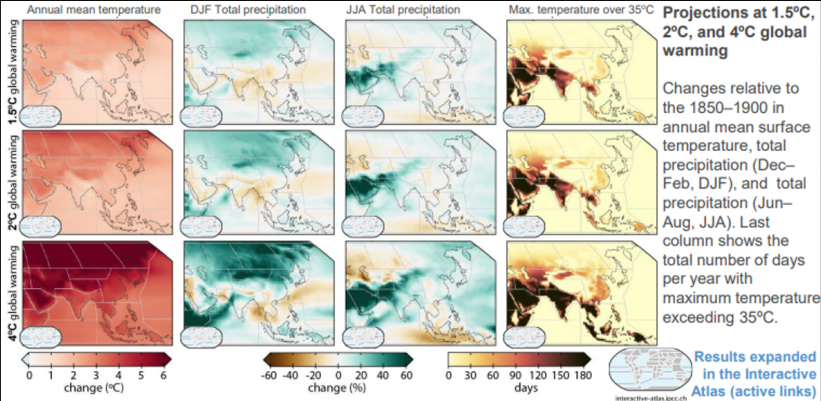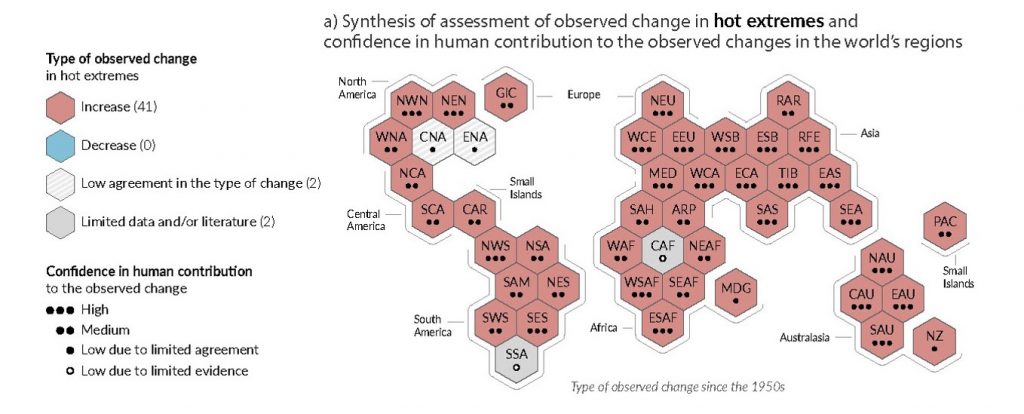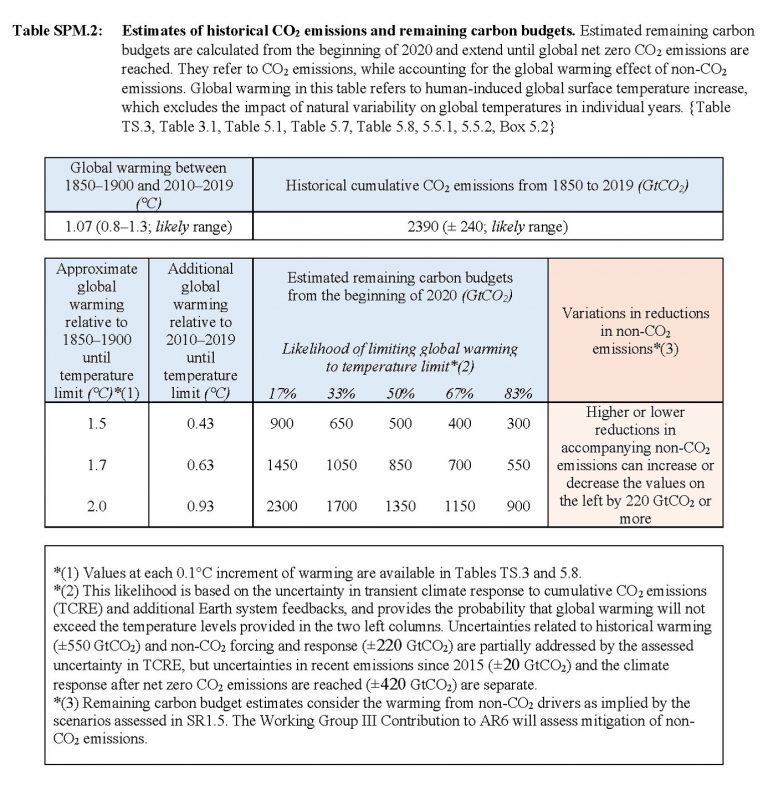Please help us improve PreventionWeb by taking this brief survey. Your input will allow us to better serve the needs of the DRR community.
Highlights: IPCC AR6 WG1 and its relevance to the Philippines

Unequivocal, unprecedented, irreversible, rapid and widespread. These are strong words used in the report of the Working Group I (WG1) of IPCC’s Sixth Assessment Report (AR6) released last August 9, 2021.
IPCC AR6 WG1: The Physical Science Basis of Climate Change
- It is unequivocal that human influence has warmed the atmosphere, ocean and land.
- Global surface temperature will continue to increase until at least the mid-century.
- The scale of changes of the climate system is unprecedented over many centuries to thousands of years.
- Rising temperature is causing irreversible changes in the climate system.
These are some of the major findings of the Working Group 1 report of the IPCC’s AR6.
Greenhouse Gas (GHG) emissions caused by human activities have significantly warmed the planet, leading to unprecedented and irreversible changes to the climate system. These findings are not new, but the Intergovernmental Panel on Climate Change (IPCC) authors now speak with certainty more than ever. The changes caused by global warming are rapid and widespread as was stipulated in the report.
As global surface temperature continues to rise, so does the extent of the changes in the climate system. This equates to more frequent and more intense extreme events such as hot extremes, marine heat waves and heavy precipitation, agricultural droughts, and sea ice and snow cover reductions.
Why are the findings important to the Philippines?
The Philippines is one of the countries most affected by / vulnerable to the changing climate; the country has a lower coping capacity to the damaging effects of extreme weather events and may need more time to rebuild and recover (compared to more developed countries)
Proof of vulnerability: The Philippines ranked 4th among the countries most affected by extreme weather events in 2000-2019 (Long-term Global Climate Risk Index).
- For the period 2000-2019, the country experienced a total of 317 weather-related events, the highest among the most affected countries
- Global Climate Risk Index (CRI) analyzes quantified impacts of extreme weather events in terms of fatalities and economic losses
- The CRI does not provide an all-encompassing analysis of the risks of anthropogenic climate change, but contributes to understanding countries’ exposure and vulnerability to climate-related risks based on the most reliable quantified data available – alongside other analyses.
Causes of vulnerability: The Philippines’ climate vulnerability is mainly due to its geographic location and archipelagic structure.
- Its location is to the east of the Western North Pacific (WNP) Ocean, the most active ocean basin in terms of tropical cyclone (TC) activity on the planet. The WNP basin accounts for about 1/3 of global TC activities per year.
- The country’s archipelagic structure exposes it to other natural hazards, such as storm surges, tsunamis, floods and landslides. About 60% of the country’s population and 10% of major cities are situated along the country’s vast coastlines.
- In terms of non-climate and non-weather risks, the country is also located within the Pacific Ring of Fire, which also exposes it to earthquakes and volcanic eruptions.
What do the findings mean given our climate risks?
The IPCC AR6 WG1 findings indicate that the impacts we are already experiencing from climate change will get worse. Increased temperatures will also exacerbate our current climate risks:
Sea Level Rise
As the ocean gets warmer, the water expands and increases in volume. This thermal expansion and the melting of sea ice and snow cover leads to sea level rise. Given the archipelagic structure of our country, sea level rise means more frequent tidal flooding, coastal inundation, destructive soil erosion, wetland flooding, aquifer and agricultural soil contamination with salt, and loss of habitats for fish, birds, and plants.
Relative sea level around Asia has increased faster than the global average, with coastal area loss and shoreline retreat. Regional-mean sea level will continue to rise (IPCC AR6 Regional Fact sheet).
In the case of the Philippines, the sea surface height of Manila Bay has already increased by 0.80 m from 1947 to 2012. It is projected to increase by half a meter more by mid-century and by up to 1.33 m by 2100 under the highest emissions scenario where no additional climate policy is implemented (SSP5-8.5).
More Intense Tropical Cyclones
Warmer sea surface generally provides more energy for storm development and thus favors more intense TCs. This means more powerful and even larger, thus more destructive tropical storms.
Increased Rainfall
The increase in the amount of rainfall during heavy rainfall events is driven by an increase in atmospheric water vapour (IPCC AR6). Warmer atmosphere leads to more surface water evaporation over some regions. As warmer air rises, it is able to bring more moisture into the atmosphere. As air condenses eventually, this leads to more rain clouds and heavier rainfall over other locations. This could lead to flooding over some areas, and drought over other regions.
Compounded Extreme Events
Unprecedented compound extreme events, where multiple extreme events of either different or similar types occur simultaneously or in succession, may be more probable and severe. Heat wave/ extreme heat during drought increases the risk of forest fires and agricultural damages and losses. Sea level rise may induce higher storm surges caused by intense typhoons. Intensification of extreme events may lead to greater economic losses and fatalities.
Droughts and Heat Waves
Warmer air evaporates more water from reservoirs, crops and forests which leads to agricultural and ecological droughts.
Future heat waves are also expected to last longer and have higher temperatures, which can lead to agricultural droughts, decreased ocean productivity, and human health concerns.
What are the impacts of these projected risks to sectors and ecosystems?

Global temperatures reaching the 1.5 °C threshold implies more frequent severe droughts, heavy precipitation, flooding, heatwave, and typhoons to most of the world.
The Philippines is highly vulnerable to the severe impacts brought about by climate change. Below are some of the impacts that we can expect from our increased risks:
- Increased intensity in typhoons and flooding will not only result in damage to properties and livelihood. Just in 2020, the country experienced another Super Typhoon (Typhoon Goni or locally known as Rolly), which caused massive destruction.
- Rising global temperatures can also cause more frequent El Niño and La Niña events in the Pacific (at medium confidence)–intensifying droughts during the former while increasing the amount of precipitation leading to intense flooding for the latter. With agriculture still one of the main industries of the country, extensive droughts can result in damaged agricultural crops and less water supply, threatening both food and water security.
- Forest fires have also started to occur more frequently and in greater magnitude, affecting large areas of forest and biodiversity
- Sea surface temperatures continue to rise due to the oceans absorbing 91% of the excess heat caused by GHG, consequently resulting in low oxygen levels and ocean acidification. In the Philippines, a decline of around 9% of fisheries GDP and coral bleaching was observed owing to rising ocean temperatures.
- For sea level rise, given the archipelagic structure of our country, the phenomenon exposes coastal communities and their livelihoods to inundation and occasional tidal flooding. In addition, sea level rise can also result in accelerated coastal erosion, shoreline retreat, intensify storm surges, wetland flooding, saltwater intrusion, and lost habitat for fish, birds, and plants.
- Urban areas are also expected to experience the impacts of increasing severity of heatwaves, mean and heavy precipitation, downward wind of cities, runoff, and flooding.
- Lastly, climate change can directly affect human health as extreme heat, polluted air, and severe weather events and hazards may result in heat strokes, increased water and vector-borne diseases, respiratory illnesses, and malnutrition.
How do we know that these changes are man-made?

The report emphasizes that climate change is enhanced by human activities, particularly:
- Humans contribute to climate change through the emission of greenhouse gases. Over the past 171 years, human activities have raised atmospheric concentrations of CO2 by around 48% above pre-industrial levels found in 1850 (NOAA). Increased CO2 emissions by humans is said to have contributed 1.1 °C of warming 1850-1900 (AR6-WG1 Press Conference).
- High levels of CO2 emission is identified by IPCC as the main driver of climate change, even with air pollution and other greenhouse gases considered as contributors (AR6-WG1 Press Conference).
- According to the Summary for Policy Makers (SPM), there is a near-linear relationship between cumulative anthropogenic CO2 emissions and global warming (at high confidence).
What can we do?
With humans contributing to climate change, IPCC also states that humans have the capability to stabilize the climate by reducing GHG emissions, which will be accomplished through net zero. Net zero emissions are achieved when anthropogenic emissions of greenhouse gases to the atmosphere are balanced by anthropogenic removals over a specified period.
- From a physical science perspective, limiting human-induced global warming to a specific level requires limiting cumulative CO2 emissions, reaching at least net zero CO2 emissions, along with strong reductions in other greenhouse gas emissions. Strong, rapid and sustained reductions in methane (CH4) emissions would also limit the warming effect resulting from declining aerosol pollution and would improve air quality.
- Policymakers, at all levels of government, must take decisive steps and scale up action towards confronting the climate crisis. The plans on how to realize the targets in the Nationally Determined Contributions (NDCs) should reflect on what is being recommended in the IPCC reports. Investing in nature-based solutions, phasing out of coal-fired power plants, and transitioning to renewable energy must be considered while realizing ecosystem integrity and just transition without displacing the most vulnerable.
- At the community level, changing the attitude towards science and making evidence-based decisions are ways to motivate people to take actions that will help address the climate crisis.
- Collective action should be at the forefront of every call to confront the overwhelming reality brought about by climate change.
More information on the impacts and recommended actions of climate change are available in the Philippine Climate Change Assessment Reports (PhilCCA).
Why is the PhilCCA important?
The Philippines is one of the countries most vulnerable to the effects of climate change. Localizing global information is key to understanding how the changing climate affects the way of life of Filipinos. The PhilCCA Reports provide a clear and updated synthesis of the current state of scientific knowledge on climate change in the country, its impacts, vulnerabilities of various sectors, and adaptation and mitigation strategies, which can be instrumental in shaping policies to help build the resilience of Filipinos.
For the second cycle of the PhilCCA Reports, scientific literature published within the last five years will be synthesized by authors composed of the country’s top/ leading scientists, various stakeholders and relevant actors.
Explore further
Please note: Content is displayed as last posted by a PreventionWeb community member or editor. The views expressed therein are not necessarily those of UNDRR, PreventionWeb, or its sponsors. See our terms of use
Is this page useful?
Yes No Report an issue on this pageThank you. If you have 2 minutes, we would benefit from additional feedback (link opens in a new window).